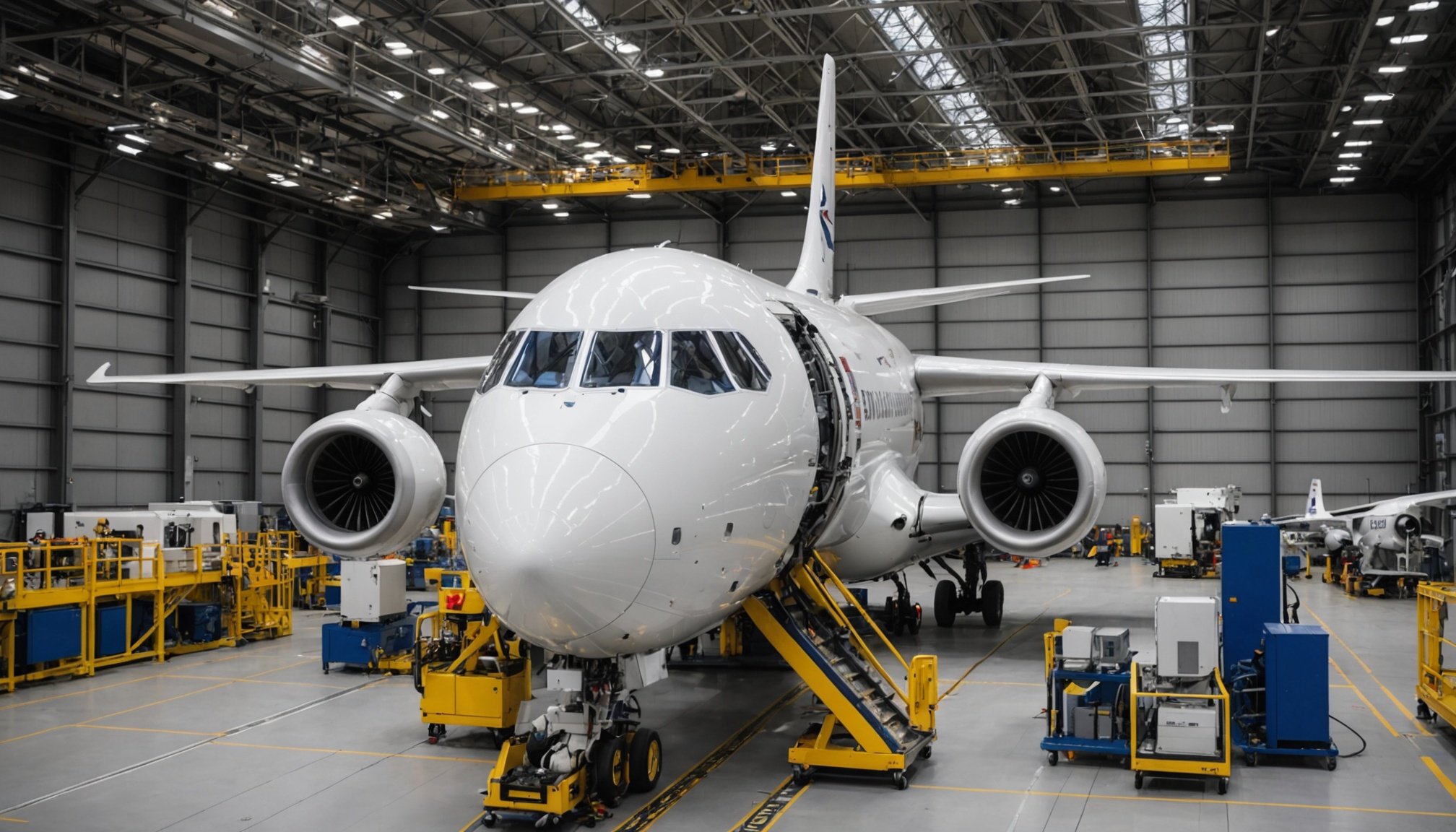Overview of AI in Aerospace Maintenance
Artificial Intelligence (AI) in aerospace is revolutionising predictive maintenance processes. Predictive maintenance involves using AI technologies to forecast equipment failures before they occur, thereby reducing unexpected downtimes and enhancing safety. The implementation of aerospace technology in predictive maintenance allows for systematic data collection and a detailed analysis of equipment health.
In the UK, the aerospace sector is actively integrating AI to boost the effectiveness of maintenance operations. AI technologies provide invaluable insights, enabling maintenance teams to optimise their schedules and techniques. This shift not only saves costs but also extends the lifespan of aerospace components. By utilising advanced aerospace technology, companies can transition from reactive to proactive maintenance, addressing potential issues before they escalate.
Also to read : Transforming Disaster Recovery: Cutting-Edge AI Tactics to Boost Resilience in UK Businesses
The landscape of AI in aerospace is continually evolving, with UK companies at the forefront of these advancements. The use of predictive maintenance has been instrumental in achieving operational efficiency and safety enhancements. AI technologies such as machine learning and data analytics are crucial tools in this transformation, offering precise and timely interventions. The integration of these innovations represents a significant leap towards increased reliability and functionality in the aerospace industry.
Current AI Technologies Used in Predictive Maintenance
Implementing cutting-edge AI technologies in predictive maintenance is transforming how aerospace firms handle equipment upkeep. These technologies are pivotal in maintenance optimization, making operations more efficient and proactive.
Also to discover : Transforming City Commutes: How AI is Enhancing Traffic Management in Modern UK Smart Cities
Machine Learning Applications
Machine learning algorithms play a crucial role in analysing large datasets to predict maintenance needs. By learning from historical data, these algorithms can identify patterns indicative of potential failures. Machine learning empowers maintenance teams to tailor their approaches, reducing unnecessary inspections and repairs while ensuring reliability.
IoT and Sensor Technologies
The Internet of Things (IoT) and sensor technologies collect real-time data from equipment, offering panoramic insights into an asset’s health. This constant data stream enables timely detection of anomalies, which is essential for initiating corrective measures before malfunctions occur. The integration of IoT devices streamlines monitoring and enhances decision-making processes in aerospace maintenance.
Predictive Analytics Tools
Predictive analytics tools are another vital component, offering sophisticated platforms to analyse and interpret data from connected devices. These tools improve maintenance schedules by forecasting equipment needs more accurately. By harnessing data analytics, aerospace firms can plan resources better, thereby generating cost savings and boosting operational uptime. This forward-thinking approach significantly elevates predictive maintenance capabilities.
Benefits of AI in Predictive Maintenance
The integration of AI in aerospace brings substantial benefits to predictive maintenance, with notable efficiency improvements and cost savings. By harnessing AI technologies, maintenance operations become more streamlined and effective. Statistics reveal that AI-driven maintenance improves system reliability by forecasting and addressing equipment failures in advance, thus reducing the likelihood of unexpected downtimes.
Cost savings are a significant advantage, as AI-based systems enable more accurate scheduling and resource allocation. This results in lesser routine checks and extends the life of aerospace components. Financial resources are further optimised by avoiding unnecessary repairs and focusing on components that genuinely require attention.
Moreover, safety enhancements are a critical outcome of AI’s predictive capabilities. By predicting potential failures, AI allows for proactive measures, thereby enhancing the overall safety of operations. Predictive insights lead maintenance teams to prioritise intervention areas, minimising risks associated with equipment malfunctions.
These benefits highlight AI’s transformative role in the aerospace industry. It optimises maintenance by ensuring operations are not only cost-effective but also safe and reliable, marking a significant advancement in how aerospace companies manage their assets.
Challenges and Risks of AI Adoption in Aerospace
Integrating AI technologies into the aerospace sector presents numerous implementation risks and industry barriers. One of the primary challenges is incorporating AI into existing maintenance frameworks. Legacy systems might not seamlessly interface with modern AI solutions, necessitating substantial overhauls or cumbersome workarounds. Additionally, the complexity of aerospace technology further complicates integration efforts.
Another critical concern is data security. AI relies heavily on data, making it an attractive target for cyber threats. Ensuring that sensitive information remains secure while algorithms process vast datasets is paramount. Equally important is achieving algorithm transparency. Understanding AI decision-making processes is essential for trust and operational safety. Opaque algorithms could lead to mistrust among maintenance teams and other stakeholders.
The industry also faces resistance due to cultural shifts. Adapting to AI demands changes in workforce skills and mindset. Traditional maintenance teams might be reluctant to adopt AI-driven methods due to perceived job threats or unfamiliarity with new technologies. Emphasising the benefits of AI, like reducing tedious tasks and enhancing decision-making, could mitigate these concerns. However, comprehensive training and open communication are crucial to overcoming such industry barriers.
Case Studies of AI Implementation in UK Aerospace
Incorporating AI technologies has transformed maintenance operations in the UK aerospace sector. Various case studies demonstrate how AI implementation can yield remarkable outcomes. One leading UK aerospace company effectively utilised AI to optimise its predictive maintenance strategies, resulting in substantial cost savings and efficiency gains.
The company adopted machine learning algorithms to analyse historical data, accurately predicting maintenance needs and reducing unexpected downtimes. This approach enabled the firm to detect potential equipment failures before they occurred, much like high precision methods in the Stanford Question Answering Dataset (SQuAD) where accurate predictions are vital. As a result, maintenance operations became more targeted and efficient, lessening the financial burden of unplanned interventions.
Another significant finding from these case implementations is the enhanced reliability of AI-driven maintenance practices compared to traditional methods. Companies reported a decline in routine inspection overheads, allowing engineers to focus on critical tasks that demanded immediate attention. Lessons learned from these successes highlight the importance of integrating AI technologies with existing systems, fostering better decision-making and strategic planning. By showcasing the advantages and learning from comparative outcomes, the UK aerospace industry can harness AI to redefine its maintenance landscape.
Future Implications of AI in Aerospace Maintenance
The horizon of AI advancements in aerospace is expansive, promising significant evolution in maintenance practices. Capturing these future trends, industry experts foresee a shift towards more integrated systems where AI technologies are inherently woven into the fabric of predictive maintenance. This integration facilitates real-time analytics, enabling an unprecedented level of maintenance optimization.
Looking forward, AI is set to bolster data analytics capabilities, allowing aerospace companies to harness vast amounts of data with precision akin to the Stanford Question Answering Dataset (SQuAD) methodology. Such advancements could lead to self-diagnosing systems, where predictive maintenance becomes autonomous, swiftly identifying and resolving potential issues without human intervention.
Over the next decade, the maintenance evolution will likely see AI-driven tools, such as digital twins—virtual replicas of physical systems—offering predictive insights and enhancing decision-making processes. These tools are anticipated to streamline aerospace operations, ensuring both efficiency improvements and cost savings.
Finally, the long-term implications for the aerospace sector include not only technical evolution but also a cultural shift towards embracing technological change. Preparing for this future involves skill development and mindset adjustments, ensuring that workforce adaptation aligns with these pioneering developments.











